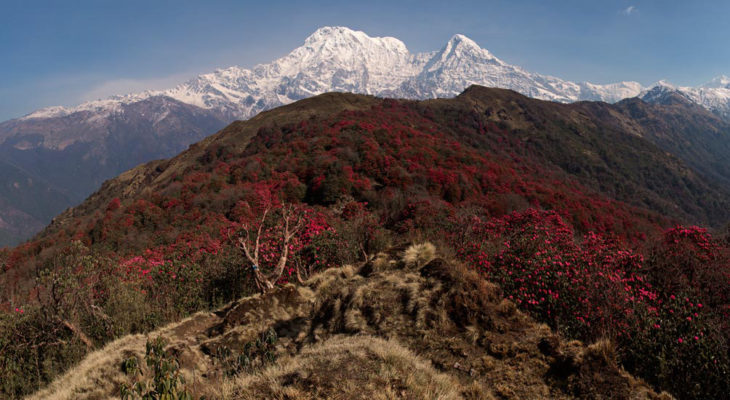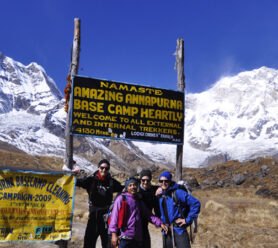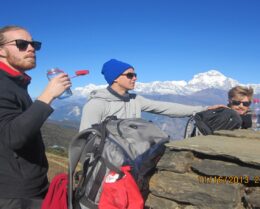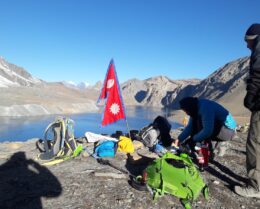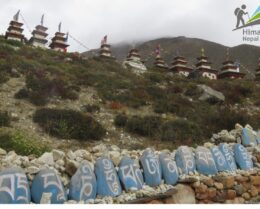Mardi Himal Trek
- difficulty
- Moderate
- altitude
- 4500m
- group size
- 1-10
- meals
- B+L+D
- accomodation
- Lodges
- season
- Sep-Nov/March -May
trip overview
One of the hiking peaks in the Annapurna Himalaya is Mardi Himal. It is located in the Kaski district at a height of 5587 meters. One of Nepal’s simpler Himalayan peaks to scale is this one. Situated below Mount Machhapuchhre, one of Nepal’s most beautiful alpine peaks. This place is 27 kilometers from Pokhara. You may enjoy the vistas sans the throng on the Mardi Himal Trek. Real teahouses, gorgeous rhododendron woods, and the best views of the Annapurna Himalayan Range are to be expected.
The less visited location, ecotourism, and natural hiking path in the well-known Annapurna region are called Mardi Himal Trek. Mardi Himal hiking is located beautifully at the foot of Mardi Himal, which is 5587 meters high, as well as the majestic Himachuli mountain range, the Annapurna range, and the city of Pokhara with its Fewa Lake. Because there are no communities and few hikers, Mardi Himal is a really peaceful trekking route. It started this voyage in 1961 AD. Trekkers may also take in the vibrant rhododendron blooms along the way in the months of March and April. You may get fantastic views of the Annapurna Massif’s lesser-known flanks on the Mardi Himal Trek.
The Mardi Himal Trek plan shows a 45-minute journey from Pokhara to Phedi followed by an ascent to the Dhampus Gurung settlement at 1650 meters. There is a stone-paved route that leads from Pothana (1890 meters) to Deurali 4500 meters, Kokar Forest Camp (close-up views of Ghandruk), Low Camp, High Camp, and Kali Danda (excellent views of mountain peaks, views of the Annapurna Trek, and the Pokhara Valley). Via Landruk, Ghandruk, and Ghorepani, we climb down to Kokar Forest Camp before descending to Pokhara.
The Mardi Himal Trek might be difficult to complete. But, this does not imply that you cannot succeed. You can make it if you enjoy hiking and make sure to start working out well before the start of your adventure. One of the hiking peaks in the Annapurna Himalaya is Mardi Himal. It is located in the Kaski district at a height of 5587 meters. One of Nepal’s simpler Himalayan peaks to scale is this one. Situated below Mount Machhapuchhre, one of Nepal’s most beautiful alpine peaks. Due to its calmness and grand vistas, Mardi Himal is becoming more and more well-known. If you’re searching for a quick and scenic hike in the mountains, this tour is perfect for you.
Although the typical Mardi Himal Trek is not challenging, hikers and trekkers should nevertheless be in fair physical condition. You are still traveling across Nepal’s Mountains, after all. There weren’t a lot of teahouses on this journey at first, but since about 2011, there have been more tea houses along the entire route from the beginning to the Mardi Himal Base Camp. The Mardi Himal Trek is among the top unexplored hikes in the Annapurna area. You have the option to deviate from the norm and hike to Annapurna Base Camp at a location where few others would choose to do so.
itinerary
Arrival in Kathmandu Nepal 1300M/30 Min.
Our office staff will be waiting at the international airport to pick up you in a private vehicle and transfer you to the booked hotel in Kathmandu, after rest, we will brief you about the Mardi Himal trek and introduce you to your guide and porters.
Walking / Driving: Driving
Kathmandu to Pokhara by Tourist Bus 900M/6-7 hours.
Many options to go to Pokhara where air, private and deluxe tourist buses. We manage our guests as our guests’ interests and what they prefer for their travel to Pokhara.
Itinerary Meal: B
Accommodation: Lodges
Walking / Driving: Driving
Pokhara to Deurali 2100M/5-6 hours.
We left the Guesthouse in Pokhara around 7 am and drove to the trailhead, Dhampus Phedi, arriving there just before 8 am, the route from Phedi is a good one and very few trekkers choose to start the trek from here. The trail is gradually up to Dhampus village then flat and then after an early lunch slightly uphill to Pothana (1950m) and the ACAP / TIMS checkpoint, then up again to Deurali (2100m).
Itinerary Meal: B+L+D
Accommodation: Lodges
Walking / Driving: Walking
Deurali to Kokar Forest Camp 2520M/6 hours.
There is a right turn in Deurali signposted “Forrest Camp” the trail is through the jungle, at first up then undulating on the top of a ridge, there is a section just over halfway where the trail drops steeply and then slowly gains height and then back onto the ridge and into Forrest Camp (2600m) after about 4-hour trekking. There are now 3 lodges in Forrest Camp.
Itinerary Meal: B+L+D
Accommodation: Lodges
Walking / Driving: Walking
Kokar Forest Camp to Low Camp 2970M/4-5 hours.
The trail is initially quite steep leaving Forrest Camp but soon gets less steep as you again get upon the ridge, about an hour up from Forrest Camp there is a new teahouse called “Rest Camp” which doesn’t as yet appear on the trekking maps, this would make a viable alternative if you arrive at Forrest Camp and have both strength and daylight available – From Forrest Camp to Low Camp is only a short day trekking through more jungle with occasional glimpses of Annapurna South before getting into Low Camp (2970m) after around 2 ½ to 3 hours. Although there are 2 lodges in Low camp only as two lodges also, they open just one.
Itinerary Meal: B+L+D
Accommodation: Lodges
Walking / Driving: Walking
Low Camp to High Camp 3700M/5 hours.
The trail leaves Low Camp again in the jungle, but the trees soon start to get smaller and after about one hour of trekking I broke out of the jungle and onto the open ridge with spectacular views of Machhapuchhre ahead, and Annapurna South to my left. The trail then undulates along the ridge and after about 3 hours of trekking, we arrived at High Camp (3700m).
Itinerary Meal: B+L+D
Accommodation: Lodges
Walking / Driving: Walking
Explore day
Hike to Mardi Himal Base Camp (4500m) and return to High Camp in around another 4 -5 hours. This makes a long day but there is also a viewpoint about halfway, from where you can see awesome views then continue to Mardi Himal Base Camp West and overnight at High Camp.
Itinerary Meal: B+L+D
Accommodation: Lodges
Walking / Driving: Walking
High Camp to Kokar Forest Camp 2520M/5-6 hours.
Having a hot breakfast in high camp, trek descending to low camp then inside the jungle then if group feel hungry can have lunch, then trek down to Forest camp for overnight.
Itinerary Meal: B+L+D
Accommodation: Lodges
Walking / Driving: Walking
Kokar Forest Camp to Jhinu 1780M/5-6 hours.
Forest Camp to Jhinu trail takes a 5-6hours for trekkers which roughly and the trail is easy and Nepali flat. The trail Landruk is down then all the way flat to Himalpani, slightly up to new bright then straight to Khomrong River after that slice of cake uphill to Jhinu Danda. Jhinu Danda is a famous place for natural hot springs all trekkers love to stay inside the natural hot water pool and then overnight at the lodge.
Itinerary Meal: B+L+D
Accommodation: Lodge
Walking / Driving: Walking
Jhinu dada to Pokhara 850M/ 4-5 hours walk 2 hours’ drive.
Having breakfast in Jhinu then trek start to walk all the way to Nayapul then take a private to Pokhara over nigh at the lodge.
Itinerary Meal: B+L+D
Accommodation: Lodge
Walking / Driving: Walking/Driving
Pokhara to Kathmandu 1300M/6-7hours drive.
By deluxe tourist bus, it takes 6-7 hours from Pokhara to Kathmandu. There is another option airway, private vehicle too.
Walking / Driving: Driving
what's included
- The airport picks up and drops services on arrival day and departure.
- Kathmandu to Pokhara by deluxe tourist bus.
- Pokhara tourist bus station to hotel by car.
- Pokhara to Dhampus Phedi by car.
- Nayapul to Pokhara by car.
- All meals (Breakfast, Lunch, and Dinner during the trek).
- Accommodation along the trek.
- License holder guide ((Including his food, lodge, insurance, transportation, equipment, salary, etc.)
- All required legal documents (TIMs and ACAP Permit).
- Trekking equipment; (Sleeping bag and Down jacket)
- All government taxes.
- Trekking and city map.
- First aid medical box.
- Fresh and dry fruits during the trek.
- Token of love from the company.
- Farewell lunch or dinner as a suitable time.
what's excluded
- Extra night hotel in Kathmandu/Pokhara.
- Travel Insurance
- Drinks: coca, mineral water, beer, hot shower, battery charge, WIFI, etc.
- Some snacks; chocolate, bars, etc.
- Tips are expected.
Fixed Departure
| departure date | price | |
|---|---|---|
| 2 May, 2024 - 11 May, 2024 | $416 | Enquire Now |

